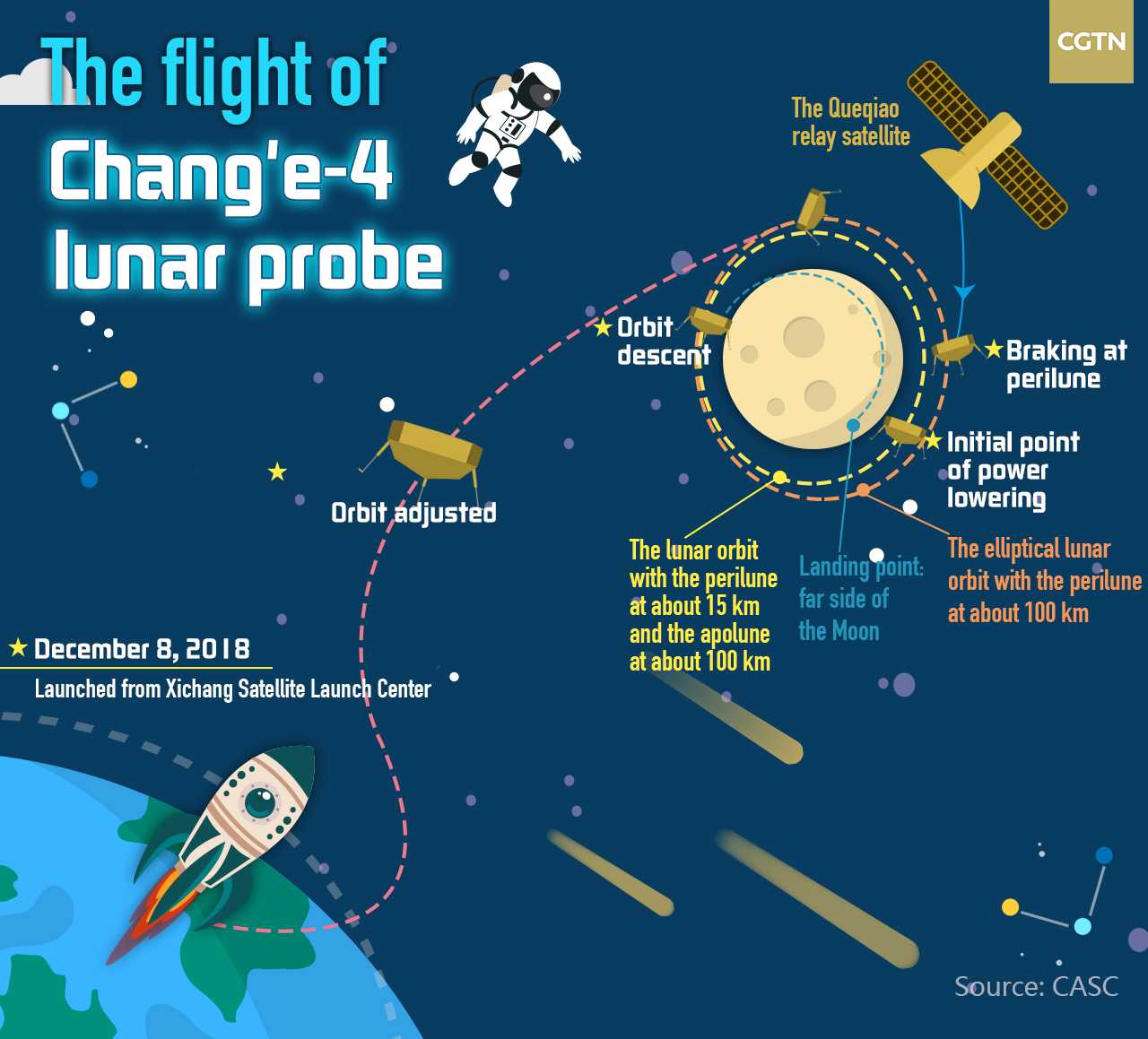
Space
12:26, 03-Jan-2019
China's Chang'e-4 probe spearheads a new chapter of Moon exploration
Updated
11:25, 06-Jan-2019
By Gao Yun

China's Chang'e-4 lunar probe has successfully soft-landed on the far side of the Moon, a great feat in humanity's lunar exploration.

CGTN infographic by Yin Yating
CGTN infographic by Yin Yating
A Moon detector
We always see the same side of the Moon, and its far side remains invisible as the Moon is tidally locked to the Earth, rotating at the same rate that it orbits our planet.
It is not an easy process for the probe to make the soft landing.

CGTN infographic by Yin Yating
CGTN infographic by Yin Yating
Composed of a lander and a rover, the probe will detect topography, material composition and the shallow structure of the landing and inspection areas, and conduct the world's first lunar-based low-frequency radio astronomical observation, according to Sun Zezhou, chief designer of Chang'e-4 mission.
With the payloads, the probe will carry out research and environmental detection on the lunar surface.
"In terms of both engineering and scientific significance, the Chang'e-4 mission is the most-anticipated one in the international scientific community in 2018," said Wu Yansheng, president of China Aerospace Science and Technology Corporation (CASC). "It will leave an indelible mark on China's scientific and technological development.
Why land on this basin?
The destination for Chang'e-4 probe is the Von Kármán crater in the South Pole-Aitken (SPA) basin, a huge and old impact crater on the far side (the southern hemisphere) of the Moon.
It will play a significant role in helping people learn more about the Moon.
The SPA basin is so far the largest known impact basin in the solar system, stretching from the south pole to Aitken crater at the other end, just as its name suggests. As deep as 13 kilometers, it is also the deepest impact basin on the Moon, which means that the impact probably excavated material deep in the lunar crust and even down to the mantle. The basin may potentially provide samples for the study of the Moon's interior composition.
As large and deep as it is, the SPA basin is also one of the oldest basins on the Moon. Formed about 3.92 billion years ago, it is a crucial site to study the Moon's 4.5-billion history.
The 186-kilometer-diameter Von Kármán crater, located at the middle part of the basin, is of high scientific interest.
The crater is typical in geomorphic type, material composition and geological age and is rich in thorium, iron oxide, and titanium dioxide. The abnormal spatial distribution of the material composition may provide clues to volcanic and lunar crust activities in the region, and therefore helpful to the study of the origin of lunar mantle basalt.
Meanwhile, the southern terrain of the crater is relatively flat, providing favorable conditions for the probe's landing.
Exploration of Moon and deeper space
Both the Chang 'e-4 mission and the future exploration of the north and south poles of the Moon belong to China's 4th-phase lunar exploration, said Ye Peijian, an expert with the China Aerospace Science and Technology Corporation Fifth Academy.
The main missions of the 4th phase include exploring the north and south poles of the moon with the aid of robots, establishing unmanned lunar research stations, and integrating the lander, robot and staff on the ground for better cooperation.
"During the fourth lunar exploration phase, the Chinese probe will land on more places on the Moon, explore more things, and involve more robots," said Ye.
China's space exploration will expand from the Moon to the deeper universe, and four major tasks can be expected according to China National Space Administration, including launching a probe to the Mars, sampling and taking back Martian surface materials, conducting an asteroid exploration, and planning a probe to Jupiter and planet.
(Cover via VCG)

SITEMAP
Copyright © 2018 CGTN. Beijing ICP prepared NO.16065310-3
Copyright © 2018 CGTN. Beijing ICP prepared NO.16065310-3